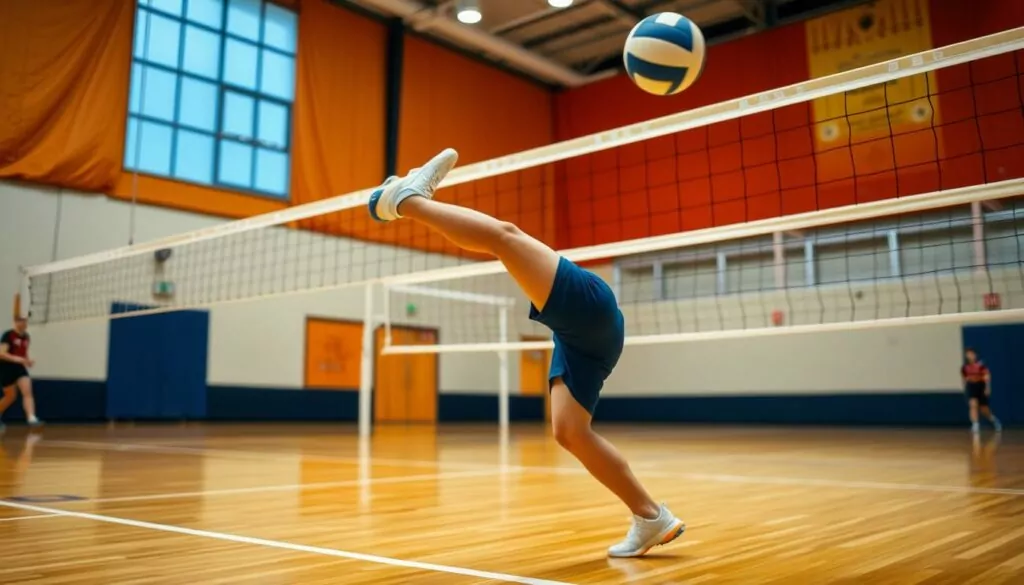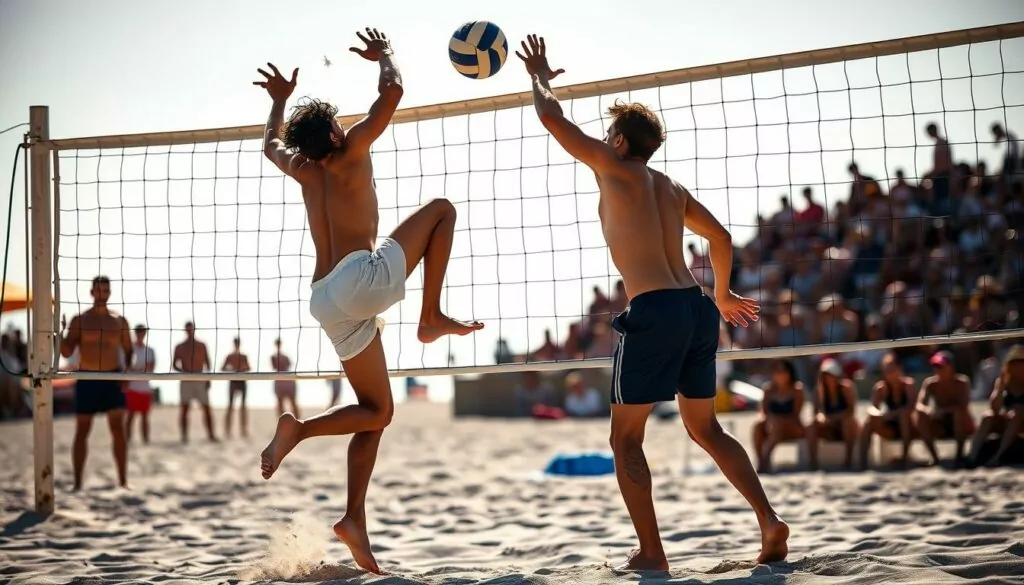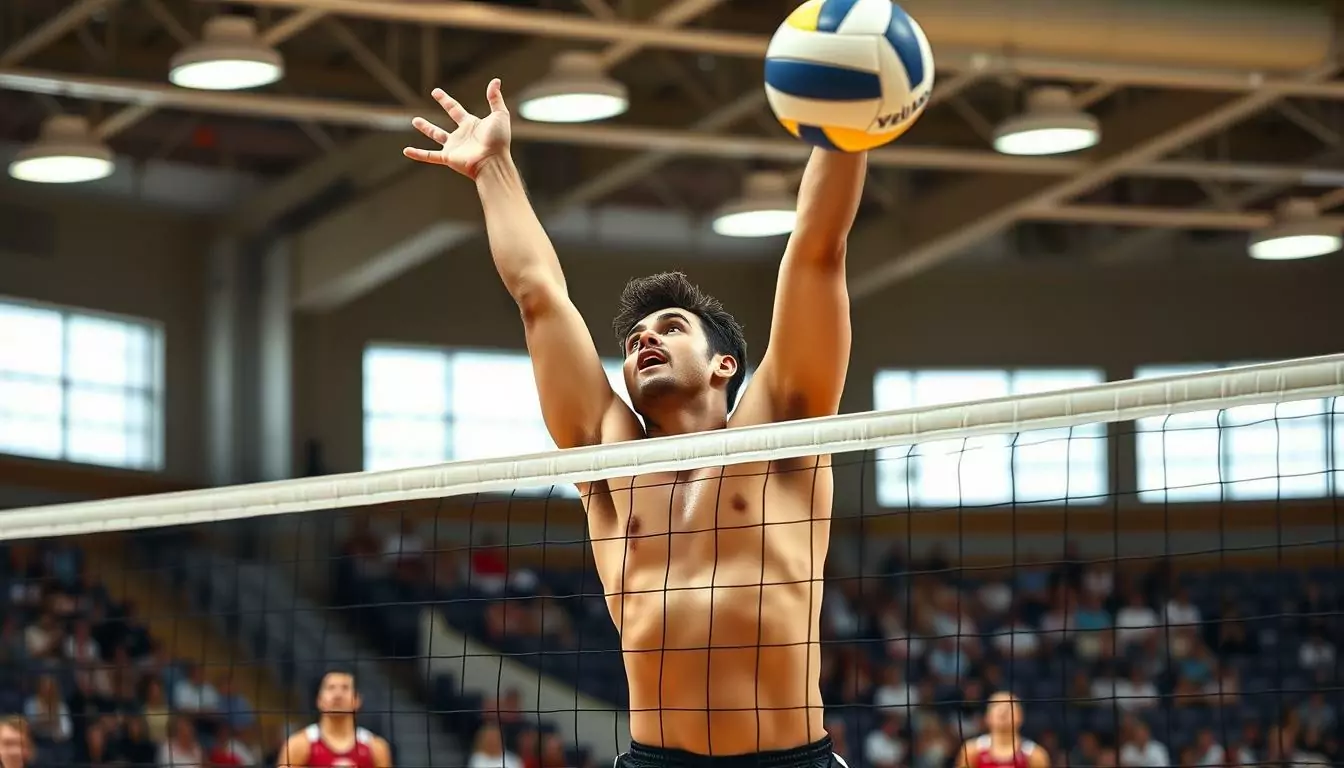Blocking in volleyball is an exciting skill. It’s about reading attacks, timing jumps, and stopping opponents. Mastering this can change the game’s momentum and assert dominance at the net.
I recently watched a high-level volleyball match. The blocking was incredible. Teams moved in sync, reacted quickly, and fought for net control. It showed that blocking isn’t just individual skill.
Effective blocking combines technique, strategy, and teamwork. It’s a powerful tool for defensive success.
I’m thrilled to share key blocking strategies and techniques. These have helped my team become strong defenders. Mastering blocking can boost your game and team’s defense.
Let’s explore how to become a volleyball blocking expert. These tips work for both new and experienced players.
Key Takeaways
- Understanding the fundamental techniques of proper hand positioning, core body positioning, and reading the opponent’s attack
- Developing essential blocking skills, including footwork patterns, quick transition movements, and approach timing
- Implementing effective blocking strategies for different positions on the court
- Mastering advanced jump blocking mechanics, such as penetration techniques and block coverage zones
- Coordinating team efforts in double and triple blocks to maximize defensive coverage
- Identifying and addressing common blocking errors, including timing issues, position mistakes, and communication problems
- Embracing the mental aspects of blocking, such as anticipation, confidence, and adaptability
Understanding Basic Blocking Fundamentals

Mastering volleyball blocking requires understanding key techniques. Proper positioning and reading opponent attacks are crucial. These fundamentals will elevate your game at the net.
Proper Hand Positioning and Reach
Strong blocking starts with correct hand positioning. Face your palms towards opponents and spread your fingers wide. Extend your arms fully to maximize reach at the net.
This creates an intimidating barrier for opposing hitters. It allows you to cover more area and deflect balls effectively.
Core Body Position at the Net
A solid blocking stance generates power and stability. Keep feet shoulder-width apart with knees slightly bent. Distribute your weight evenly and engage your core muscles.
This foundation enables quick jumps and position adjustments. It helps maintain control throughout the blocking process.
Reading the Opponent’s Attack
Effective blocking requires anticipating attack patterns. Observe the hitter’s approach, body position, and set trajectory. This awareness helps you position yourself more effectively.
You can close off angles and force hitters to change shots. This skill is crucial for shutting down the opposition’s offense.
“The key to successful blocking is not just about physical ability, but also about mental acuity and anticipation. By mastering the fundamentals, you can become a formidable presence at the net.”
Becoming a dominant blocker requires continuous learning and practice. Focus on these blocking fundamentals to improve. You’ll build an impenetrable wall at the net and lead your team to success.
Essential Volleyball Block Technique Development
Mastering volleyball blocking is crucial for defensive success. Consistent practice refines blocking technique and boosts overall defensive skills. Let’s explore key drills to enhance your volleyball block technique.
Perfecting Hand Positioning and Reach
Proper hand positioning is vital for effective blocking. Volleyball block technique demands high hands with spread fingers facing the ball. Practice drills focusing on hand placement and reaching high to improve blocking efficiency.
Developing Explosive Jumps
Explosive vertical jumps are essential for volleyball blocking. Add plyometric exercises like box jumps to your training routine. These help develop power for effective block timing.
Regular blocking drills volleyball involving jumping and reaching will boost your blocking skills.
Mastering Timing and Anticipation
Timing and anticipation are key to successful volleyball blocking. Participate in drills that challenge you to read and react to opponent attacks. Study game footage to understand different hitter tendencies and improve your blocking technique.
Volleyball block technique development requires dedication and patience. Consistent practice of these drills will help you dominate at the net. Keep learning and refining your skills for continuous improvement.
Mastering Blocking Footwork Patterns

Effective volleyball blocking needs more than timing and positioning. Mastering footwork patterns is vital for maximizing defensive impact. Let’s explore key techniques to elevate your game.
Side-Step vs Crossover Methods
Two main blocking footwork methods exist: side-step and crossover. The side-step involves shifting weight and moving laterally. The crossover uses a dynamic, crossing-over step.
Each approach has advantages. The best choice depends on positioning, attack angle, and personal comfort.
Quick Transition Movements
Blocking footwork volleyball requires swift transitions between movements. Change direction, adjust your base, and react to the hitter’s approach quickly. Practice drills emphasizing rapid, agile footwork to build this skill.
Approach Timing Fundamentals
Understanding blocking timing volleyball is crucial. Know when to start your approach, jump, and contact the ball. Watch the hitter’s wind-up, approach, and release carefully.
Time your movements to maximize reach and impact at the net. This will improve your blocking performance significantly.
Mastering these blocking footwork aspects will help you develop versatile net defense. You’ll be ready to adapt to any offensive situation.
“The foundation of great blocking is built on mastering the fundamentals of footwork and timing. Invest the time to hone these skills, and you’ll see your defensive impact skyrocket.”
Volleyball Blocking Strategies for Different Positions

Blocking is a key defensive skill in volleyball. It varies based on a player’s position. Let’s explore one-on-one and triple block strategies for different roles.
Middle blockers shine at one-on-one one-on-one blocking volleyball. They aim to stop the opponent’s main hitters. With great leaps and timing, they can neutralize the other team’s attacks.
Outside and opposite hitters often team up for triple blocks. This covers more net area, making scoring harder for opponents. Working together, they create a strong wall against attacks.
| Position | Blocking Strength | Blocking Strategy |
|---|---|---|
| Middle Blocker | Exceptional Vertical Leap | One-on-one Blocking |
| Outside Hitter | Coordination with Opposite Hitter | Triple Blocking |
| Opposite Hitter | Complementary to Outside Hitter | Triple Blocking |
Knowing position-specific blocking strategies is crucial. It helps teams build a strong defense. Mastering these techniques can lead to more victories on the court.
Advanced Jump Blocking Mechanics
Jump blocking is a vital defensive skill in volleyball. Advanced mechanics can boost your game significantly. Let’s explore blocking angles, penetration techniques, and proper landing.
Penetration Techniques
Effective blocking involves more than reaching up at the net. Penetration disrupts the opponent’s attack by reaching into their hitting zone. This requires explosive jumps, precise timing, and strategic hand placement.
Mastering these techniques increases your chances of successful blocks. It’s a skill that sets apart great blockers from good ones.
Block Coverage Zones
Blocking isn’t just about timing and reach. It’s about understanding different angles and attack zones. Recognize common hitting patterns to position yourself effectively.
This knowledge helps you cover likely attack options. You’ll anticipate and react to shots more accurately.
Landing and Recovery
The landing and recovery phase is crucial in jump blocking. Proper technique maintains defensive readiness for the next play. Focus on controlled, balanced landings.
Quick position resets prepare you for the next attack. This attention to detail can significantly impact your team’s defense.
Mastering advanced jump blocking takes time and dedication. It requires a deep understanding of the game. These techniques will enhance your defensive skills and team value.
Team Coordination in Double and Triple Blocks
Effective triple block volleyball requires seamless coordination among teammates. Successful volleyball blocking strategies depend on communication, positioning, and timing. These elements help create a solid defensive wall at the net.
Communication is vital for a strong blocking wall. Blockers must talk constantly, calling out hitter tendencies and coverage responsibilities. This real-time dialogue ensures everyone is ready to react.
Proper positioning is crucial for blockers. They need to form a straight line, facing the attack. This alignment allows them to jump together, creating a unified barrier.
Timing is equally important in blocking. Blockers must rise as one to maximize their reach. This synchronized movement helps disrupt the opposing hitter’s shot effectively.
| Key Aspects of Team Coordination | Description |
|---|---|
| Communication | Constant dialogue between blockers to identify hitter tendencies, coverage responsibilities, and necessary adjustments |
| Positioning | Blockers aligning in a straight line, with shoulders and hips facing the attack |
| Timing | Blockers jumping together to create a unified barrier at the net |
Mastering these coordination principles can elevate a team’s blocking game. It frustrates opposing hitters and turns defense into a powerful offensive tool. Teams can achieve new heights in triple block volleyball and volleyball blocking strategies.
Common Blocking Errors and Solutions
Mastering volleyball blocking is an ongoing journey. Even seasoned athletes can struggle with common blocking errors. With the right mindset and targeted practice, these challenges can be overcome.
Timing Issues
Timing is a prevalent blocking problem. Slow reactions or incorrect jumps can put you behind the opposing hitter. Jump training helps improve explosive movements and quick reflexes.
Visualizing plays and anticipating attacks can also enhance timing. Practice these skills regularly to see improvement in your blocking performance.
Position Mistakes
Proper positioning is crucial for effective blocking. Footwork drills and maintaining a strong base can improve positioning. Game-like scenario drills help develop a better understanding of net positioning.
Communication Problems
Effective communication is vital for successful blocking. Being vocal on the court and clearly calling out hitters improves team coordination. Team-based blocking drills enhance collective awareness and responsiveness.
